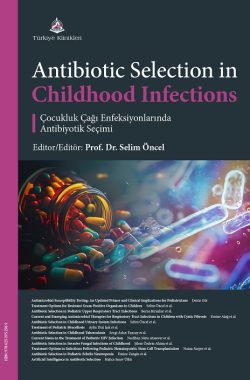Antibiotic Selection in Childhood Tuberculosis
Sevgi ASLAN TUNCAYa , Pınar CANİZCİ ERDEMLİa , Nevin HATİPOĞLUb
aMarmara University Faculty of Medicine, Division of Pediatric Infectious Diseases, İstanbul, Türkiye
bUniversity of Health Sciences Faculty of Medicine, İstanbul Bakırköy Dr. Sadi Konuk Training and Research Hospital, Clinic of Pediatric Infectious Diseases, İstanbul, Türkiye
Aslan Tuncay S, Canizci Erdemli P, Hatipoğlu N. Antibiotic selection in childhood tuberculosis. Öncel S, ed. Antibiotic Selection in Childhood Infections. 1st ed. Ankara: Türkiye Klinikleri; 2024. p.52-64.
ABSTRACT
Pediatric tuberculosis (TB) is one of the leading causes of death for children under fifteen years of age. 1.1 million children are infected with TB annually, and 10 percent of them are under five years of age. To reduce mortality rates in children, it is crucial to identify high-risk groups, improve diagnostic methods, and offer treatment options. However, detecting TB in children is challenging due to nonspecific symptoms and the difficulty in collecting sputum samples. Current diagnostic tools are less sensitive to detecting TB in children, leading to underdiagnosis and delays in treatment. Additionally, the lack of child-friendly anti-TB medications and prolonged treatment duration further complicate the situation. To address these challenges, improved diagnostic methods, such as rapid molecular tests or novel biomarkers, and the availability of child-friendly formulations of anti-TB medications are needed. These efforts will help reduce the burden of pediatric TB and improve overall outcomes for affected children.
Keywords: Antitubercular agents; latent tuberculosis; prevention and control; tuberculosis; multidrug-resistant tuberculosis
Kaynak Göster
Referanslar
- Bagcchi S. WHO's Global Tuberculosis Report 2022. Lancet Microbe. 2023;4(1):e20. [Crossref]
- Maphalle LNF, Michniak-Kohn BB, Ogunrombi MO, Adeleke OA. Pediatric tuberculosis management: a global challenge or breakthrough?. Children (Basel). 2022;9(8):1120. [Crossref]
- Accessed: 2023-09-14 [Link]
- Chakaya J, Petersen E, Nantanda R, Mungai BN, Migliori GB, Amanullah F, et al. The WHO Global Tuberculosis 2021 Report-not so good news and turning the tide back to End TB. International Journal of Infectious Diseases. 2022;124:S26-29. [Crossref]
- Accessed: 2023-09-14 [Link]
- Peña MJM, García BS, Baquero-Artigao F, Pérez DM, Pérez RP, Echevarría AM, et al. Tuberculosis treatment for children: An update. Anales de Pediatría (English Edition). 2018;88(1):52-e1. [Crossref]
- Pelosi U, Pintus R, Savasta S, Fanos V. Pulmonary tuberculosis in children: a Forgotten disease? Microorganisms. 2023;11(7):1722. [Crossref]
- Accessed: 2023-09-14 [Link]
- Tüberküloz Saha Rehberi, Sağlık Bakanlığı, Ankara-2019. Available at: , accessed 25 September 2023. [Link]
- Accessed: 2023-10-22 [Link]
- Accessed: 2023-10-22 [Link]
- Donald PR, Maher D, Qazi S. A research agenda to promote the management of childhood tuberculosis within national tuberculosis programmes. Int J Tuberc Lung Dis. 2007;11(4):370-80.
- Broger T, Sossen B, du Toit E, et al. Novel lipoarabinomannan point-of-care tuberculosis test for people with HIV: a diagnostic accuracy study. Lancet Infect Dis. 2019;19(8):852-61. [Crossref]
- Aggerbeck H, Ruhwald M, Hoff ST, et al. C-Tb skin test to diagnose Mycobacterium tuberculosis infection in children and HIV-infected adults: A phase 3 trial. PLoS One. 2018;13(9):e0204554. [Crossref]
- Zar HJ, Cotton MF, Strauss S, et al. Effect of isoniazid prophylaxis on mortality and incidence of tuberculosis in children with HIV: randomised controlled trial. BMJ. 2007;334(7585):136. [Crossref]
- Accessed: 2023-09-15 [Link]
- Accessed: 2023-10-15. [Link]
- WHO consolidated guidelines on tuberculosis. Module 4: treatment - drug-resistant tuberculosis treatment, 2022 update. Geneva: World Health Organization; 2022. Available at: 1 September 2023. [Link]
- American Academy of Pediatrics. Summaries of Infectious Diseases. In: Kimberlin DW, Barnett ED, Lynfield R, Sawyer MH, eds. Red Book: 2021 Report of the Committee on Infectious Diseases. Itasca, IL: American Academy of Pediatrics; 2021. p.787-815.
- WHO consolidated guidelines on tuberculosis. Module 5: management of tuberculosis in children and adolescents. Geneva: World Health Organization; 2022. Available at: accessed 31 August 2023. [Link]
- Jenkins HE, Yuen CM. The burden of multidrug-resistant tuberculosis in children. Int J Tuberc Lung Dis. 2018;22(5):3-6. [Crossref]
- Global Tuberculosis Report 2022. Geneva: World Health Organization; 2022. Available at: accessed 1 September 2023. [Link]
- Harausz EP, Garcia-Prats AJ, Law S, et al. Treatment and outcomes in children with multidrug-resistant tuberculosis: A systematic review and individual patient data meta-analysis. PLoS Med. 2018;15(7):e1002591.
- WHO consolidated guidelines on drug-resistant tuberculosis treatment. Geneva: World Health Organization; 2019. Available at: accessed 1 September 2023. [Link]
- Mirzayev F, Viney K, Linh NN, et al. World Health Organization recommendations on the treatment of drug-resistant tuberculosis, 2020 update. Eur Respir J. 2021;57(6):2003300. [Crossref]
- Schaaf HS, Marais BJ. Management of multidrug-resistant tuberculosis in children: a survival guide for paediatricians. Paediatr Respir Rev. 2011;12(1):31-8. [Crossref]
- Newton SM, Brent AJ, Anderson S, Whittaker E, Kampmann B. Paediatric tuberculosis. Lancet Infect Dis. 2008;8(8):498-510. [Crossref]
- Schaaf H, Michaelis I, Richardson M, Booysen C, Gie R, Warren R, et al. Adult-to-child transmission of tuberculosis: Household or community contact? Int J Tuberc Lung Disease. 2003;7:426-31.
- WHO treatment guidelines for drug-resistant tuberculosis, 2016 update. Geneva: World Health Organization; 2016. Available at: accessed 21 September 2023. [Link]
- WHO operational handbook on tuberculosis. Module 4: treatment - drug-resistant tuberculosis treatment. Geneva: World Health Organization; 2020. Available at: accessed 10 September 2023. [Link]
- Falzon D, Schünemann HJ, Harausz E, et al. World Health Organization treatment guidelines for drug-resistant tuberculosis, 2016 update. Eur Respir J. 2017;49(3):1602308. [Crossref]
- Pharmacokinetic study to evaluate anti-mycobacterial activity of TMC207 in combination with background regimen (BR) of multidrug-resistant tuberculosis (MDR-TB) medications for treatment of children/adolescents pulmonary MDR-TB. Available at: accessed 21 August 2023. [Link]
- Chiang SS, Starke JR. Etiologic Agents of Infectious Diseases: Mycobacterium tuberculosis. In: Long SS, Prober CG, Fischer M, Kimberlin DW, eds. Principles and Practice of Pediatric Infectious Diseases. 6th ed. Philadelphia, PA.; 2023. p.806-22. [Crossref]
- A family-centered approach to the treatment and prevention of drug-resistant tuberculosis in children and adolescents: counseling tools and approach. Khayelitsha, South Africa: Médecins Sans Frontières, 2021. Available at: accessed 19 September 2023. [Link]

